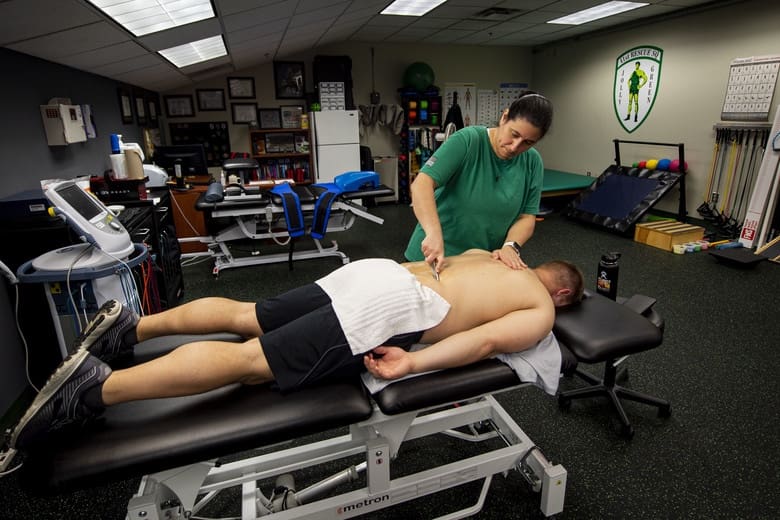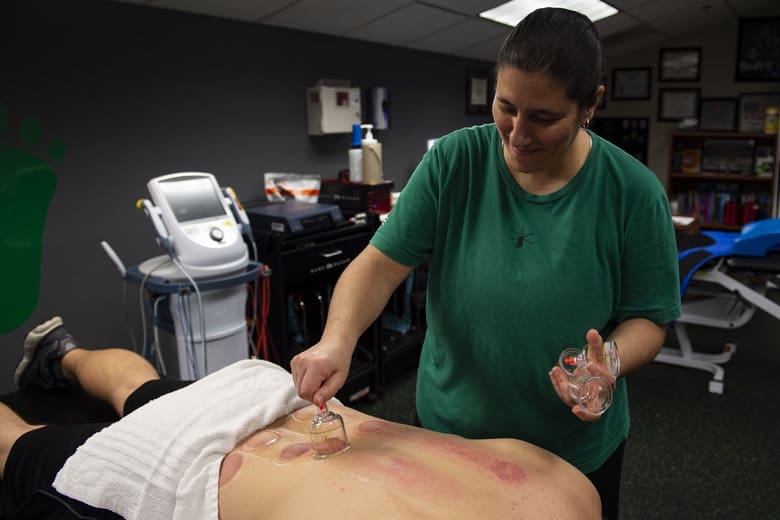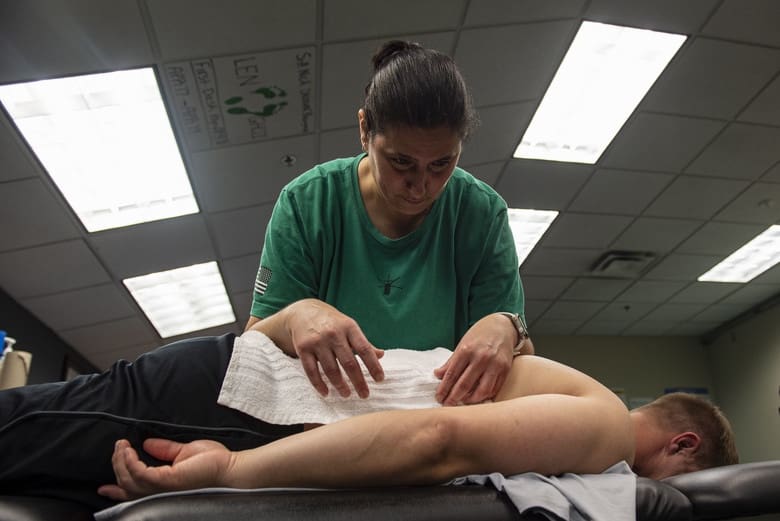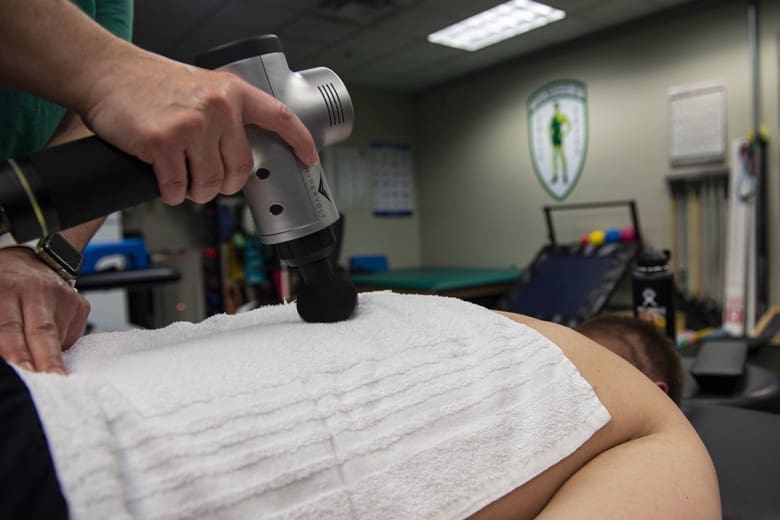MOODY AIR FORCE BASE, Ga. —
The 41st Rescue Squadron executes a physically demanding mission of personnel recovery, in doing so, rescue members require a recovery of their own.

Lori Uretsky, 41st Rescue Squadron athletic trainer, provides these Rescue Airmen with preventative care and treatment for injuries to keep them mission ready.
“[Uretsky] does preventative maintenance,” said Tech Sgt. John Rosenberg, 347th Operations Support Squadron special missions aviator. ”She keeps minor injuries from becoming major injuries and sustains chronic injuries. Taking care of [injuries] on a regular basis keeps them from becoming major issues, which could take me off the flying schedule and have a direct impact on the mission.”

Uretsky has been working with the 41st RQS since October 2017 and has had more than 2,200 appointments and tended to 3,112 injuries.
“I see a lot of neck pain, upper back and lower back pain for the pilots and the special mission aviators usually have shoulders and knee pains because of their job duties,” Uretsky said. “When I say neck and back pain that can range from muscle tightness to herniated disks to stress fractures in their back. I will say for the most part, a lot of neck pain [comes] from wearing helmets and night vision goggles because it adds weight to their head.”

Rosenberg, a patient of Uretsky’s, has been being seeing her for a leg injury for about a year.
“I’ve been having problems with scar tissue in my ankle” Rosenberg said. “We’ve been working on physical therapy with the ultrasound and sticks on my leg. It’s helping break all that stuff up. Yes, it hurts, but at the same time, I can actually feel it getting better. The prevented maintenance that she does is what enables me to still fly.”

In addition to treating injuries with dry needling, cupping and physical therapy, Uretsky provides annual and post-surgery rehabilitation services that help get wounded Airmen back in the game.
“I was unfortunately fortunate that we had someone get hurt downrange and sent back early for surgery,” Uretsky said. “I say unfortunate, because I never want that to happen, but I was able to do his rehab with him here in-house and get him cleared to return to fly. So, what we thought was going to be career ending, wasn’t. He’s back flying. So, I mean, that is really rewarding to see that.”
According to Uretsky, she has only had to deny seven Airmen from flight, which is lower than numbers seen in previous years because Uretsky is, not only on hand to provide her services here, but has the ability to travel with the unit.

“I’m going to the red flag exercise next month. This will be my second TDY,” Uretsky said. “This red flags a little shorter last year. [It lasted for] five to six weeks. They’d fly three, four times a week, have all their issues, then have to wait for when they come back [for treatment]. So even though I’m not there the whole time, I go in the smack dab of it, treat them and [which should] last until they can come back and see me again.
“I am able to do teleconferences if [Airmen] have issues. I’ve sent things downrange so that they would be able to take care of [issues] the best they could before they had to go to a major base to get treated.”

Uretsky believes being embedded in the squadron also makes a big difference in the relationships between her and her patients.
“I love my relationships with the patients,” Uretsky said. “I joke all the time and tell them that they’re a tad bit crazy for going into a bad scene probably getting shot at to go save others. Most people would go away from that kind of stuff. So, I think they’re very special. To be able to take care of them is awesome. My dad and my grandfather are vets. So, working with the military is my way of giving back.
“If I help one person and keep them in their career, then that makes me happy,” Uretsky said.
By Airman Azaria E. Foster, 23d Wing Public Affairs


Cupping? Come on, thats a hoax
Feel free to explain your rationale, and I’ll be happy to explain why it’s not.
There is no real science behind it. There is no empirical data to suggest that it Works.
Its a placebo, and thats fine, because a placebo gives you a window to give actual treatment while the patient is in a state of temporary betterment due to the effect of the placebo. But to suggest that it is a viable treatment on its own is just silly.
With respect,
It works or doesn’t isn’t really specific enough. I use this method, as do many practitioners to facilitate motor learning acquisition.
When most people refer to the notion that cupping, needling, and flossing do not work, they are referring to studies that show no tissue change. Which I 100% agree with, but no practitioner worth their salt is making those claims anyway. It takes 9000 newtons of force to deform fascia. Cupping isn’t going to do that.
What we’re doing is facilitating a learning window for the nervous system. That’s really it. So in that respect, it ‘works’. I would love to expand on the mechanical properties of cupping/flossing/scraping techniques, but this isn’t the right forum for it.
I don’t want to assume what you do for a living, but I would also state that most (not all) people who discount these methods likely don’t practice or work with athletes themselves.
The key is utilizing these methods and movement together-then it typically works.
Colour me jealous.
I wish all Combat Arms units up here had a therapist assigned to them!
It’s god awfully slow, but it’s my hope it ends up like this someday.
And in other news, the army purchased 20,000,000 in Motrin for herniated discs and acl tears yesterday…
You sallies with your Motrin… Back when I was in we only had dirt to rub on our injuries. And my old 1st sausage didn’t even have dirt when he came up!
This is s good moment to give a big thanks to the great people at the joint Army/VA Physical Therapy clinic in Fayetteville!
Therapeutic massage would probably be more beneficial than all the treatments she performs.
Cupping “seems” to work for some patients and not at all for others. Even placebos are effective about ? of the time.
The military should encourage their osteopathic physicians to use OMM more often. My wife, was a DO in the USAF, and had excellent return to duty rates from musculoskeletal injuries using OMM and reasonable conditioning and strengthening exercise regimens